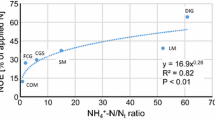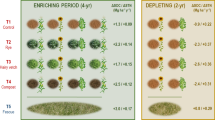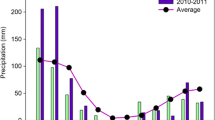Abstract
More efficient use of green manure-derived nitrogen (N) may improve crop yields and reduce environmental impacts in stockless organic arable farming. In this 3-month incubation study, we tested a new strategy where green manure leys are harvested and preserved until the following spring either as compost mixed with straw or as silage of harvested ley biomass. Grass-clover compost or silage was soil-incorporated by either simulated ploughing (green manure placed at 15 cm depth) or harrowing (green manure mixed into the upper 5-cm soil horizon) in order to assess treatment effects on net release of plant-available N, nitrous oxide (N2O) fluxes and soil respiration. Grass-clover silage provided the highest net N release with similar results for the two incorporation methods. Up to one third of the total N content in silage became plant-available during the 3 months. In contrast, no net N release was observed for the composted grass-clover and straw mixture. In fact, soil incorporation of compost by harrowing caused temporal immobilization of soil mineral N. Silage incorporated by ploughing gave rise to the largest N2O effluxes with silage-induced emissions corresponding to 0.3 % of applied total N. Possibly N2O production via denitrification was stimulated by oxygen-limited conditions near the decomposing silage. In contrast, compost incorporated by harrowing caused net N2O uptake, presumably an effect of reduced mineral N availability in this treatment. Overall, our study revealed that ensiled grass-clover was the best fertilizer product and that the method chosen for incorporation of green manure is likely to influence N2O emissions.




Similar content being viewed by others
References
Akiyama H, McTaggart IP, Ball BC, Scott A (2004) N2O, NO, and NH3 emissions from soil after the application of organic fertilizers, urea and water. Water Air Soil Pollut 156:113–129
Albert KR, Mikkelsen TN, Ro-Poulsen H, Arndal MF, Boesgaard K, Michelsen A, Bruhn D, Schmidt NM (2012) Solar UV-B effects on PSII performance in Betula nana are influenced by PAR level and reduced by EDU: results of a 3-year experiment in the High Arctic. Physiol Plant 145:485–500
Ambus P, Jensen ES, Robertson GP (2001) Nitrous oxide and N-leaching losses from agricultural soil: influence of crop residue particle size, quality and placement. Phyton-Ann Rei Bot A 41:7–15
Ambye-Jensen M, Johansen KS, Didion T, Kadar Z, Schmidt JE, Meyer AS (2013) Ensiling as biological pretreatment of grass (Festulolium hykor): the effect of composition, dry matter, and inocula on cellulose convertibility. Biomass Bioenerg 58:303–312
Baggs EM, Rees RM, Smith KA, Vinten AJA (2000) Nitrous oxide emission from soils after incorporating crop residues. Soil Use Manag 16:82–87
Begum N, Guppy C, Herridge D, Schwenke G (2014) Influence of source and quality of plant residues on emissions of N2O and CO2 from a fertile, acidic Black Vertisol. Biol Fertil Soils 50:499–506
Breland TA (1994) Enhanced mineralization and denitrification as a result of heterogeneous distribution of clover residues in soil. Plant Soil 166:1–12
Brozyna MA, Petersen SO, Chirinda N, Olesen JE (2013) Effects of grass-clover management and cover crops on nitrogen cycling and nitrous oxide emissions in a stockless organic crop rotation. Agr Ecosyst Environ 181:115–126
Burgess MS, Mehuys GR, Madramootoo CA (2002) Nitrogen dynamics of decomposing corn residue components under three tillage systems. Soil Sci Soc Am J 66:1350–1358
Cabrera ML, Kissel DE, Vigil MF (2005) Nitrogen mineralization from organic residues: research opportunities. J Environ Qual 34:75–79
Chapuis-Lardy L, Wrage N, Metay A, Chotte JL, Bernoux M (2007) Soils, a sink for N2O? A review. Glob Chang Biol 13:1–17
Chatskikh D, Olesen JE (2007) Soil tillage enhanced CO2 and N2O emissions from loamy sand soil under spring barley. Soil Till Res 97:5–18
Cookson W, Osman M, Marschner P, Abaye D, Clark I, Murphy DV, Stockdale E, Watson C (2007) Controls on soil nitrogen cycling and microbial community composition across land use and incubation temperature. Soil Biol Biochem 39:744–756
Dahlin A, Stenberg M, Marstorp H (2011) Mulch N recycling in green manure leys under Scandinavian conditions. Nutr Cycl Agroecosys 91:119–129
de Ruijter F, Huijsmans J, Rutgers B (2010) Ammonia volatilization from crop residues and frozen green manure crops. Atmos Environ 44:3362–3368
Doltra J, Olesen JE (2013) The role of catch crops in the ecological intensification of spring cereals in organic farming under Nordic climate. Eur J Agron 44:98–108
Dresboll DB, Thorup-Kristensen K (2005) Structural differences in wheat (Triticum aestivum), hemp (Cannabis sativa) and Miscanthus (Miscanthus ogiformis) affect the quality and stability of plant based compost. Sci Hortic-Amsterdam 107:81–89
Giannopoulos G, van Groenigen JW, Pulleman MM (2011) Earthworm-induced N2O emissions in a sandy soil with surface-applied crop residues. Pedobiologia 54:S103–S111
Gomez-Munoz B, Hatch DJ, Bol R, Dixon ER, Garcia-Ruiz R (2011) Gross and net rates of nitrogen mineralisation in soil amended with composted olive mill pomace. Rapid Commun Mass Sp 25:1472–1478
Hanselman TA, Graetz DA, Obreza TA (2004) A comparison of in situ methods for measuring net nitrogen mineralization rates of organic soil amendments. J Environ Qual 33:1098–1105
Harrison R, Ellis S, Cross R, Hodgson JH (2002) Emissions of nitrous oxide and nitric oxide associated with the decomposition of arable crop residues on a sandy loam soil in Eastern England. Agronomie 22:731–738
Hogberg MN, Chen Y, Hogberg P (2007a) Gross nitrogen mineralisation and fungi-to-bacteria ratios are negatively correlated in boreal forests. Biol Fertil Soils 44:363–366
Hogberg MN, Hogberg P, Myrold DD (2007b) Is microbial community composition in boreal forest soils determined by pH, C-to-N ratio, the trees, or all three? Oecologia 150:590–601
Holm S (1979) A simple sequentially rejective multiple test procedure. Scand J Stat 6:65–70
Iovieno P, Morra L, Leone A, Pagano L, Alfani A (2009) Effect of organic and mineral fertilizers on soil respiration and enzyme activities of two Mediterranean horticultural soils. Biol Fertil Soils 45:555–561
IPCC (2013) Contribution of Working Group I to the Fifth Assessment Report of the Intergovernmental Panel of Climate Change. In: Stocker TF, Qin D, Plattner G-K, Tignor M, Allen SK, Boschung J, Nauels A, Xia Y, Bex V, Midgley PM (eds) Climate change 2013: the physical science basis. Cambridge University Press, Cambridge, pp 1–1535
Jacobs A, Ludwig B, Schmidt JH, Bergstermann A, Rauber R, Joergensen RG (2011) Influence of tillage on degradation kinetics using the litterbag method. Eur J Soil Biol 47:198–204
Johnson JMF, Barbour NW, Weyers SL (2007) Chemical composition of crop biomass impacts its decomposition. Soil Sci Soc Am J 71:155–162
Koga N (2013) Nitrous oxide emissions under a four-year crop rotation system in northern Japan: impacts of reduced tillage, composted cattle manure application and increased plant residue input. Soil Sci Plant Nutr 59:56–68
Koga N, Tsuruta H, Sawamoto T, Nishimura S, Yagi K (2004) N2O emission and CH4 uptake in arable fields managed under conventional and reduced tillage cropping systems in northern Japan. Global Biogeochem Cycl 18, GB4025, doi:10.1029/2004GB002260
Kutzbach L, Schneider J, Sachs T, Giebels M, Nykanen H, Shurpali NJ, Martikainen PJ, Alm J, Wilmking M (2007) CO2 flux determination by closed-chamber methods can be seriously biased by inappropriate application of linear regression. Biogeosciences 4:1005–1025
Li X, Hu F, Shi W (2013) Plant material addition affects soil nitrous oxide production differently between aerobic and oxygen-limited conditions. Appl Soil Ecol 64:91–98
Lin S, Iqbal J, Hu R, Shaaban M, Cai J, Chen X (2013) Nitrous oxide emissions from yellow brown soil as affected by incorporation of crop residues with different carbon-to-nitrogen ratios: a case study in Central China. Arch Environ Con Tox 65:183–192
Liu B, Morkved PT, Frostegard A, Bakken LR (2010) Denitrification gene pools, transcription and kinetics of NO, N2O and N2 production as affected by soil pH. FEMS Microbiol Ecol 72:407–417
Loecke TD, Robertson GP (2009) Soil resource heterogeneity in terms of litter aggregation promotes nitrous oxide fluxes and slows decomposition. Soil Biol Biochem 41:228–235
Lopez-Lopez G, Lobo M, Negre A, Colombas M, Rovira J, Martorell A, Reolid C, Sastre-Conde I (2012) Impact of fertilisation practices on soil respiration, as measured by the metabolic index of short-term nitrogen input behaviour. J Environ Manag 113:517–526
Magid J, De Neergaard A, Brandt M (2006) Heterogeneous distribution may substantially decrease initial decomposition, long-term microbial growth and N-immobilization from high C-to-N ratio resources. Eur J Soil Sci 57:517–529
Mahmoud EK, Abd El-Kader NK (2012) How the nitrogen fertilization dose affects the biochemical composition and net mineralization of the artichoke residues. J Soil Sci Plant Nutr 12:23–31
McEniry J, O’Kiely P, Clipson NJW, Forristal PD, Doyle EM (2008) The microbiological and chemical composition of silage over the course of fermentation in round bales relative to that of silage made from unchopped and precision-chopped herbage in laboratory silos. Grass Forage Sci 63:407–420
Mutegi JK, Munkholm LJ, Petersen BM, Hansen EM, Petersen SO (2010) Nitrous oxide emissions and controls as influenced by tillage and crop residue management strategy. Soil Biol Biochem 42:1701–1711
Nadeem S, Hansen S, Bleken M, Dorsch P (2012) N2O emission from organic barley cultivation as affected by green manure management. Biogeosciences 9:2747–2759
Nannipieri P, Paul EA (2009) The chemical and functional characterization of soil N and its biotic components. Soil Biol Biochem 41:2357–2369
Nebert LD, Bloem J, Lubbers IM, van Groenigen JW (2011) Association of earthworm-denitrifier interactions with increased emission of nitrous oxide from soil mesocosms amended with crop residue. Appl Environ Microb 77:4097–4104
Nourbakhsh F, Dick RP (2005) Net nitrogen mineralization or immobilization potential in a residue-amended calcareous soil. Arid Land Res Manag 19:299–306
Olesen JE, Askegaard M, Rasmussen IA (2009) Winter cereal yields as affected by animal manure and green manure in organic arable farming. Eur J Agron 30:119–128
Petersen SO, Mutegi JK, Hansen EM, Munkholm LJ (2011) Tillage effects on N2O emissions as influenced by a winter cover crop. Soil Biol Biochem 43:1509–1517
Petersen SO, Ambus P, Elsgaard L, Schjonning P, Olesen JE (2013) Long-term effects of cropping system on N2O emission potential. Soil Biol Biochem 57:706–712
Ramirez KS, Craine JM, Fierer N (2010) Nitrogen fertilization inhibits soil microbial respiration regardless of the form of nitrogen applied. Soil Biol Biochem 42:2336–2338
Ravishankara AR, Daniel JS, Portmann RW (2009) Nitrous oxide (N2O): the dominant ozone-depleting substance emitted in the 21st century. Science 326:123–125
Recous S, Mary B (1990) Microbial immobilization of ammonium and nitrate in cultivated soils. Soil Biol Biochem 22:913–922
Robertson LA, Dalsgaard T, Revsbech NP, Kuenen JG (1995) Confirmation of aerobic denitrification in batch cultures, using gas-chromatography and 15 N mass-spectrometry. FEMS Microbiol Ecol 18:113–119
Rosenkranz P, Brueggemann N, Papen H, Xu Z, Seufert G, Butterbach-Bahl K (2006) N2O, NO and CH4 exchange, and microbial N turnover over a Mediterranean pine forest soil. Biogeosciences 3:121–133
Rutting T, Huygens D, Boeckx P, Staelens J, Klemedtsson L (2013) Increased fungal dominance in N2O emission hotspots along a natural pH gradient in organic forest soil. Biol Fertil Soils 49:715–721
Sahrawat K (2008) Factors affecting nitrification in soils. Commun Soil Sci Plant 39:1436–1446
SAS Institute (2003) SAS/STAT user’s guide, release 9.1. Statistical Analysis System Institute, Cary
Sokal RR, Rohlf FJ (1995) Biometry: the principles and practice of statistics in biological research. W. H. Freeman and Company, New York
Sorensen JN, Thorup-Kristensen K (2011) Plant-based fertilizers for organic vegetable production. J Plant Nutr Soil Sci 174:321–332
Sørensen P, Kristensen E, Odokonyero K, Petersen SO (2013) Utilization of nitrogen in legume-based mobile green manures stored as compost or silage. In: Løes A-K, Askegaard M, Langer V, Partanen K, Pehme S, Rasmussen IA, Salomon E, Sørensen P, Ullvén K, Wivstad M (eds) NJF Seminar 461, organic farming systems as a driver for change, vol 9, NJF Report. Nordic Association of Agricultural Scientists, Stockholm, pp 157–158
Sterner RW, Elser JJ (2002) Ecological stoichiometry: the biology of elements from molecules to the biosphere. Princeton University Press, Princeton
Thomson AJ, Giannopoulos G, Pretty J, Baggs EM, Richardson DJ (2012) Biological sources and sinks of nitrous oxide and strategies to mitigate emissions. Philos T Roy Soc B 367:1157–1168
Uden P (2010) The influence of sample preparation of forage crops and silages on recovery of soluble and non-structural carbohydrates and their predictions by Fourier transform mid-IR transmission spectroscopy. Anim Feed Sci Tech 160:49–61
Van Den Bossche A, De Bolle S, De Neve S, Hofman G (2009) Effect of tillage intensity on N mineralization of different crop residues in a temperate climate. Soil Till Res 103:316–324
Wang JG, Bakken LR (1997) Competition for nitrogen during decomposition of plant residues in soil: effect of spatial placement of N-rich and N-poor plant residues. Soil Biol Biochem 29:153–162
Whitehead DC, Lockyer DR (1989) Decomposing grass herbage as a source of ammonia in the atmosphere. Atmos Environ 23:1867–1869
Wrage N, Velthof GL, van Beusichem ML, Oenema O (2001) Role of nitrifier denitrification in the production of nitrous oxide. Soil Biol Biochem 33:1723–1732
Acknowledgments
This work was part of the HighCrop project. The project is based within the Organic RDD programme, which is coordinated by International Centre for Research in Organic Food Systems, ICROFS. It is funded by The Danish AgriFish Agency, Ministry of Food, Agriculture and Fisheries. The authors wish to thank Poul T. Sørensen, Andreas Fernqvist and Jens B. Kjeldsen for their practical help when constructing the soil unit containers and during initial handling of the soil. In addition, the authors also wish to thank Mette Flodgaard, Nina Wiese Thomsen and Anja C. Nielsen for their assistance in destructive soil sampling and chemical analyses.
Author information
Authors and Affiliations
Corresponding author
Rights and permissions
About this article
Cite this article
Carter, M.S., Sørensen, P., Petersen, S.O. et al. Effects of green manure storage and incorporation methods on nitrogen release and N2O emissions after soil application. Biol Fertil Soils 50, 1233–1246 (2014). https://doi.org/10.1007/s00374-014-0936-5
Received:
Revised:
Accepted:
Published:
Issue Date:
DOI: https://doi.org/10.1007/s00374-014-0936-5




